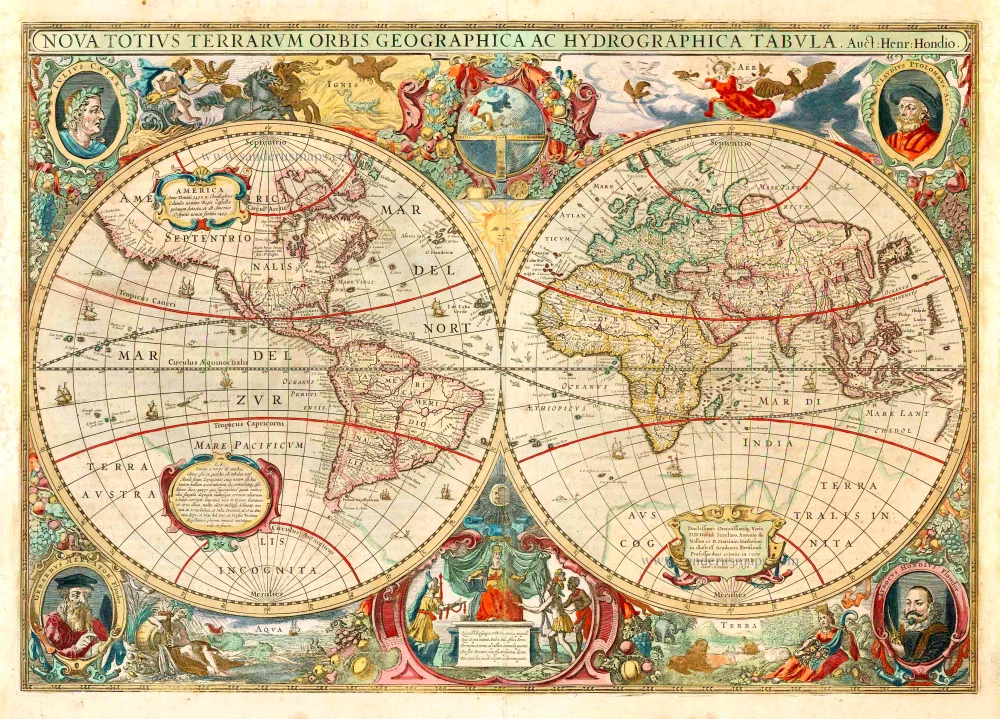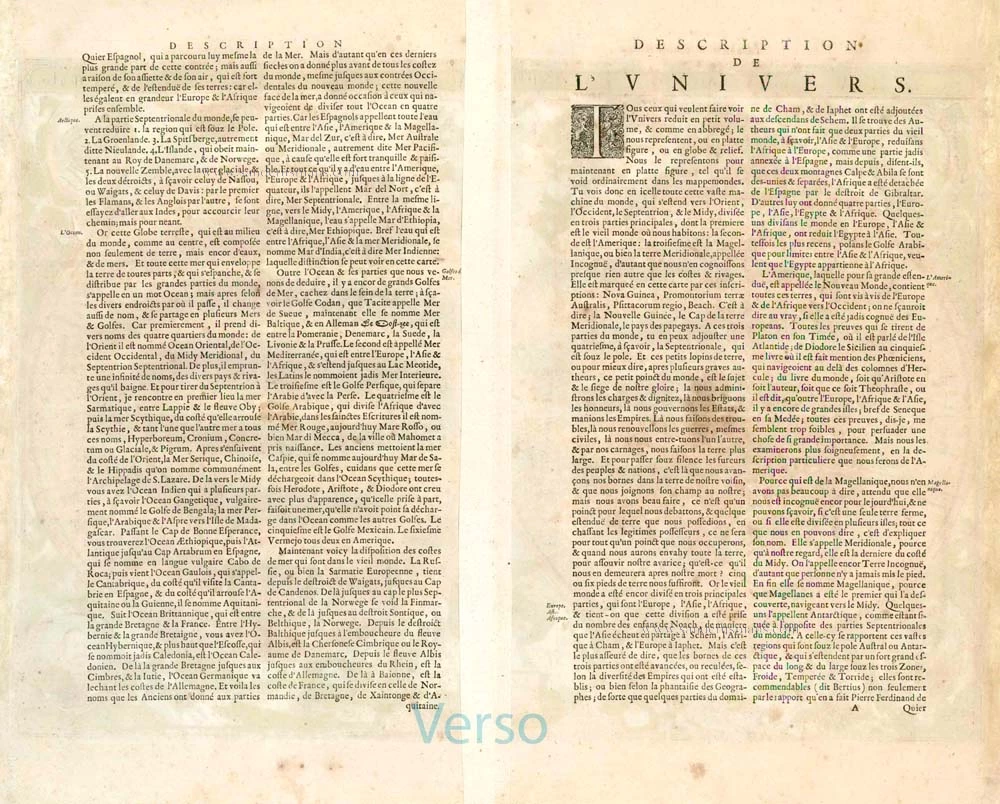World map, by Henricus Hondius. 1641
In 1629, threatened by pending competition from W.J. Blaeu and his sons, Jan Jansson and his partner Henricus Hondius set about revising the Mercator-Hondius atlas, which (in respect of the world map) had continued unchanged for nearly thirty-five years. The partners' new world map is a fine ornate example of the decorative cartography of the time. The two hemispheres are bordered by voluptuous representations of the four elements and other scenes: in the top corners are portraits of Julius Caesar and Claudius Ptolemy, and in the bottom are portraits of the author's father, Jodocus Hondius and his mentor Gerard Mercator.
For geographical detail, Hondius followed Speed and his contemporaries and presented California as an island. New features include part of the north Australian coastline extending towards New Guinea and a redrawing of north-east Canada with 'Queen Ann's forland' (Baffin Island) shown completely encircled by open water.
The Hondius-Jansson world map had as a long a life as its predecessor, as it was included in all issues of the Mercator atlas from 1633 until at least 1658. Four states have been traced with dates on the map as follows (See Shirley):
State 1 1630
State 2 1641 with Amstelodami Excudit Ioannes Ianssonius added at the bottom
State 3 1663 in Atlas Contractus of Jan Jansson and sea atlases of Van Loon
State 4 1666 in Atlas Major of Jan Jansson
The Hondius Family
Jodocus Hondius the Elder (1563-1612)
Joost d’Hondt was born at Wakken (Flanders) in 1563. Two years later, his family settled in Ghent, where young Joost displayed an excellent gift for drawing and calligraphy. Through study and lessons, he developed his talents and became an engraver with a good reputation.
Due to the circumstances of the war, he moved to London in 1584, where he settled down as an engraver, instrument-maker, and map-maker. In 1587, he married Coletta van den Keere, sister of the well-known engraver Pieter van den Keere (Petrus Kaerius); some years earlier, his sister, Jacomina, had married Pieter van den Berghe (Petrus Montanus). Joost, who had Latinized his name to Jodocus Hondius, closely co-operated with his two brothers-in-law.
The political situation in the Northern Netherlands in 1593 was such that Jodocus seemed justified in establishing himself in Amsterdam, where many Antwerp printers, publishers, and engravers had gone. In this new centre of cartography, Jodocus Hondius set up his business “In de Wackere Hondt” (in the vigilant dog), this name being an allusion to his birthplace and name. He engraved many maps and published atlases and many other works, such as his continuation of Gerard Mercator’s Atlas.
He suddenly passed away in February 1612. The publishing firm of Jodocus Hondius was continued by his widow, later on, by his two sons, Jodocus Jr. and Henricus, and by his son-in-law, J. Janssonius.
Jodocus Hondius II (1594-1629) & Henricus Hondius (1597-1651)
After the father’s death, the widow and her seven children continued publishing the atlases under the name of Jodocus Hondius till 1620. The firm was reinforced by the very welcome help of Joannes Janssonius (1588-1664), who married 24-year-old Elisabeth Hondius in 1612. After 1619, Mercator’s Atlas was published under the name of Henricus Hondius.
One of the most dramatic events in the early history of commercial cartography in Amsterdam was the sale of Jodocus Hondius Jr.’s copper plates to Willem Jansz. Blaeu in 1629, the year of his death. At least 34 plates, from which Jodocus II had printed single-sheet maps for his benefit, passed into the hands of his great competitor. Immediately after that, his brother, Henricus, and Joannes Janssonius ordered the engraving of identical plates.
Henricus devoted all his energy to publishing the Atlas for an extended period. He saw its growth up to and including the fourth part in 1646; after that, his name no longer figures on the title pages. After 1638, the title of the Atlas was changed to Atlas Novus; Joannes Janssonius mainly carried it on.
The competition with the Blaeu's dates from 1630. In 1630, Willem Janszoon (=Blaeu) first attacked with his Atlantis Appendix. In 1635, Blaeu completed his Theatrum Orbis Terrarum in two volumes with French, Latin, Dutch, and German texts, prompting Henricus Hondius to speed up the enlargement of his Atlas.
Nova Totius Terrarum Orbis Geographica ac Hydrographica Tabula.
Item Number: 26273 Authenticity Guarantee
Category: Antique maps > World and Polar
Antique world map - double hemisphere by Henricus Hondius, with corner portraits of J. Caesar, Cl. Ptolemy, G. Mercator & J. Hondius. Insular California.
Date of the first edition: 1631
Date of this map: 1641
Date on map: 1630
Dedication to David Sanclarus, Antonius de Willon and Martinius by H. Hondius.
Copper engraving
Size: 38 x 54.5cm (14.8 x 21.2 inches)
Verso text: French
Condition: Original coloured, lower centrefold reinforced.
Condition Rating: A
References: Shirley (World), 336, State 2; Van der Krogt 1, 0001:1C.2; Clancy, p.74 Map 6.2.
From: Nouveau Theatre du Monde ou Nouvel Atlas comprenant Les Tables et Descriptions de toutes les Regions de la Terre. Amsterdam, H. Hondius, 1641. (Van der Krogt 1, 412)
In 1629, threatened by pending competition from W.J. Blaeu and his sons, Jan Jansson and his partner Henricus Hondius set about revising the Mercator-Hondius atlas, which (in respect of the world map) had continued unchanged for nearly thirty-five years. The partners' new world map is a fine ornate example of the decorative cartography of the time. The two hemispheres are bordered by voluptuous representations of the four elements and other scenes: in the top corners are portraits of Julius Caesar and Claudius Ptolemy, and in the bottom are portraits of the author's father, Jodocus Hondius and his mentor Gerard Mercator.
For geographical detail, Hondius followed Speed and his contemporaries and presented California as an island. New features include part of the north Australian coastline extending towards New Guinea and a redrawing of north-east Canada with 'Queen Ann's forland' (Baffin Island) shown completely encircled by open water.
The Hondius-Jansson world map had as a long a life as its predecessor, as it was included in all issues of the Mercator atlas from 1633 until at least 1658. Four states have been traced with dates on the map as follows (See Shirley):
State 1 1630
State 2 1641 with Amstelodami Excudit Ioannes Ianssonius added at the bottom
State 3 1663 in Atlas Contractus of Jan Jansson and sea atlases of Van Loon
State 4 1666 in Atlas Major of Jan Jansson
The Hondius Family
Jodocus Hondius the Elder (1563-1612)
Joost d’Hondt was born at Wakken (Flanders) in 1563. Two years later, his family settled in Ghent, where young Joost displayed an excellent gift for drawing and calligraphy. Through study and lessons, he developed his talents and became an engraver with a good reputation.
Due to the circumstances of the war, he moved to London in 1584, where he settled down as an engraver, instrument-maker, and map-maker. In 1587, he married Coletta van den Keere, sister of the well-known engraver Pieter van den Keere (Petrus Kaerius); some years earlier, his sister, Jacomina, had married Pieter van den Berghe (Petrus Montanus). Joost, who had Latinized his name to Jodocus Hondius, closely co-operated with his two brothers-in-law.
The political situation in the Northern Netherlands in 1593 was such that Jodocus seemed justified in establishing himself in Amsterdam, where many Antwerp printers, publishers, and engravers had gone. In this new centre of cartography, Jodocus Hondius set up his business “In de Wackere Hondt” (in the vigilant dog), this name being an allusion to his birthplace and name. He engraved many maps and published atlases and many other works, such as his continuation of Gerard Mercator’s Atlas.
He suddenly passed away in February 1612. The publishing firm of Jodocus Hondius was continued by his widow, later on, by his two sons, Jodocus Jr. and Henricus, and by his son-in-law, J. Janssonius.
Jodocus Hondius II (1594-1629) & Henricus Hondius (1597-1651)
After the father’s death, the widow and her seven children continued publishing the atlases under the name of Jodocus Hondius till 1620. The firm was reinforced by the very welcome help of Joannes Janssonius (1588-1664), who married 24-year-old Elisabeth Hondius in 1612. After 1619, Mercator’s Atlas was published under the name of Henricus Hondius.
One of the most dramatic events in the early history of commercial cartography in Amsterdam was the sale of Jodocus Hondius Jr.’s copper plates to Willem Jansz. Blaeu in 1629, the year of his death. At least 34 plates, from which Jodocus II had printed single-sheet maps for his benefit, passed into the hands of his great competitor. Immediately after that, his brother, Henricus, and Joannes Janssonius ordered the engraving of identical plates.
Henricus devoted all his energy to publishing the Atlas for an extended period. He saw its growth up to and including the fourth part in 1646; after that, his name no longer figures on the title pages. After 1638, the title of the Atlas was changed to Atlas Novus; Joannes Janssonius mainly carried it on.
The competition with the Blaeu's dates from 1630. In 1630, Willem Janszoon (=Blaeu) first attacked with his Atlantis Appendix. In 1635, Blaeu completed his Theatrum Orbis Terrarum in two volumes with French, Latin, Dutch, and German texts, prompting Henricus Hondius to speed up the enlargement of his Atlas.





